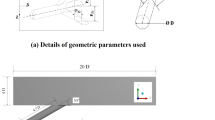Abstract
In the present work, computational simulations was made using ANSYS CFX to predict the improvements in film cooling performance with dual trench. Dual-trench configuration consists of two trenches together, one wider trench and the other is narrow trench that extruded from the wider one. Several blowing ratios in the range (0.5:5) were investigated. The pitch-to-diameter ratio of 2.775 is used. By using the dual trench configuration, the coolant jet impacted the trench wall two times allowing increasing the spreading of coolant laterally in the trench, reducing jet velocity and jet completely covered on the surface. The results indicate that this configuration increased adiabatic effectiveness as blowing ratio increased. The spatially averaged adiabatic effectiveness reached 57.6% for at M= 2. No observed film blow-off at all blowing ratios. The adiabatic film effectiveness of dual trench case outperformed the narrow trench case, laidback fan-shaped hole, fan-shaped hole and cylinder hole at different blowing ratios.
Similar content being viewed by others
References
Bunker R (2002). Film cooling effectiveness due to discrete holes within a transverse trench. ASME paper, GT2002-30178.1-10.
Harrison KL, Bogard DG (2007). CFD predictions of film cooling adiabatic effectiveness for cylindrical holes embedded in narrow and wide transverse trenches. ASME Paper, GT2007-28005. 1–10.
Jia L, Jing R, Hongde J (2010). Film cooling performance of the embedded holes in trenches with compound angles. ASME Paper, GT2010-22337. 1–10.
Lu Y, Dhungel A, Ekkad SV, Bunker RS (2009). Effect of trench width and depth on film cooling from cylindrical holes embedded in trenches. ASME Journal of Turbomachinery, 131, 1–13.
Lu Y, Nasir H, Ekkad SV (2005). Film cooling from a row of holes embedded in transverse slots. ASME Paper, GTI2005-68598. 1–8.
Saumweber C, Schulz A, Wittig S (2003). Free-Stream Turbulence Effects on film Cooling with Shaped Holes. Journal of Turbomachinery, 125, 65–73.
Sinha AK, Bogard DG, Crawford ME (1991). Film cooling effectiveness downstream of a single row of holes with variable density ratio. ASME Journal of Turbomachinery, 113, 442–449.
Waye S (2005). Film cooling effectiveness of suction side axial holes, compound angle holes, and axial holes embedded within an overlying transverse trench. M.S. Thesis, University of Texas at Austin. Austin, USA.
Waye S, Bogard D (2006). High resolution of film cooling effectiveness measurements of axial holes embedded in a transverse trench with various trench configurations. ASME Paper, GT2006-90226. 1–9.
Zuniga HA, Kapat JS (2009). Studied effect of increasing pitch-to-diameter ratio on the film cooling effectiveness of shaped and cylindrical holes embedded in trenches. ASME Paper, GT2009-60080. 1–10
Author information
Authors and Affiliations
Corresponding author
Additional information
Foundation item: Supprted by Harbin Engineering University Scholarship under Grant No. 20100903D01.
Antar M.M. Abdala is Ph.D candidate in Power and Energy Engineering College, Harbin Engineering University. His major research area is heat transfer applications and gas turbines blades cooling.
Qun Zheng is Professor in Power and Energy Engineering College, Harbin Engineering University, China. His major research area is Performance and system analysis for ship power plant totality.
Ping Dong is Associated preofessor in Power and Energy Engineering College, Harbin Engineering University, China. His main research interest is aerodynamics.
Rights and permissions
About this article
Cite this article
Abdala, A.M.M., Zheng, Q., Elwekeel, F.N.M. et al. Computational film cooling effectiveness of dual trench configuration on flat plate at moderate blowing ratios. J. Marine. Sci. Appl. 12, 208–218 (2013). https://doi.org/10.1007/s11804-013-1187-9
Received:
Revised:
Published:
Issue Date:
DOI: https://doi.org/10.1007/s11804-013-1187-9



